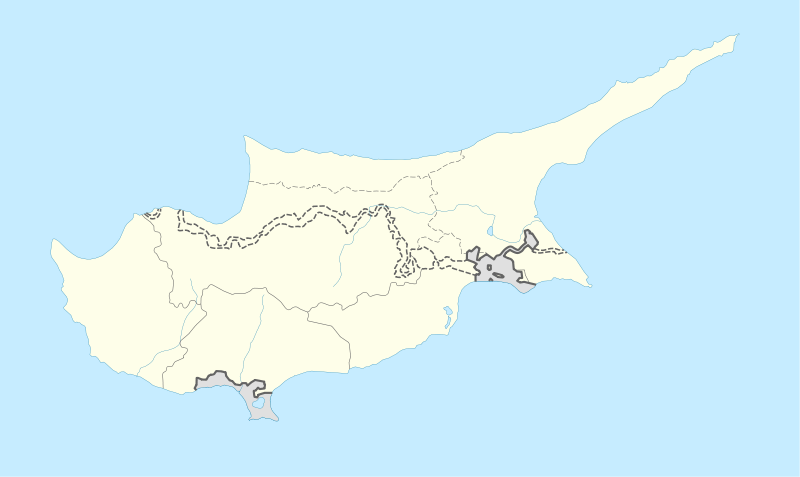Ak Kavuk, Nicosia
Ak Kavuk (Abu Kavuk) is a Neighbourhood, Quarter, Mahalla or Parish of Nicosia, Cyprus [2][3] and the mosque thereof. It is spelled as Akkavuk in Turkish and Ακ Καβούκ or Άμπου Καβούκ in Greek. Both alternative names appear in English. Jeffery [4] uses both, while the Cyprus Gazette in 1923 uses the form "Abou Kavouk".[5]
Ak Kavuk (Abu Kavuk) | |
|---|---|
| Άμπου Καβούκ, Akkavuk | |
 Ak Kavuk (Abu Kavuk) Location in Cyprus | |
| Coordinates: 35°10′52″N 33°21′50″E | |
| Country | |
| District | Nicosia District |
| Municipality | Nicosia |
| Population (2011)[1] | |
| • Total | 793 |
| Time zone | UTC+2 (EET) |
| • Summer (DST) | UTC+3 (EEST) |
At the last Census (2011) it had a population of 793.[1]
The population in 1946 was 1202,[6] consisting of 107 Greek Cypriots, 1094 Turkish Cypriots and 1 other.
History
Ak Kavuk is one of the 24 historic Neighbourhoods of Nicosia within the walls.[2] After the Ottoman conquest of Nicosia, it was divided into 12 quarters said to be derived from the 12 generals in command of divisions of the Ottoman army at the time. Each general being posted to a quarter, that quarter was known by his name. In this case the Quarter was named after General Ak Kavuk Pasha. (This is a nickname meaning "white cap.").[4]
Mosque

On the site of what appeared to be a small mediaeval chapel or church, a mosque was built in 1902. A smaller mosque on the site was built in 1895. The apse of the original building with a moulded arched window of 16th century style survived, but all such traces have now been removed.[4]
On the southern wall at opposite of the doorway, there is a mihrab with an addition of a nearby wooden mimbar.[7]
Other sites
On the Barbaro/Musalla bastion is a Turkish military encampment, within which there is a Museum of National Struggle[8]
References
- Census organised by the Turkish Cypriots in the occupied area "Archived copy" (PDF). Archived from the original (PDF) on 6 November 2013. Retrieved 16 September 2014.CS1 maint: archived copy as title (link) retrieved October 2013
- Coexistence in the Disappeared Mixed Neighbourhoods of Nicosia by Ahmet An (Paper read at the conference: Nicosia: The Last Divided Capital in Europe, organized by the London Metropolitan University on 20 June 2011)
- 6th edition of the publication "Statistical Codes of Municipalities, Communities and Quarters of Cyprus" (publ. Statistical Service of Republic of Cyprus)
- "A Description of the Historic Monuments of Cyprus" by George Jeffery,Architect .Publ. Government Printing Office, Nicosia, 1918.
- The Cyprus Gazette, 19 January 1923, Page 30
- Census of Cyprus, 1946
- Nicosia Turkish Municipality website "Archived copy". Archived from the original on 19 December 2013. Retrieved 2013-12-19.CS1 maint: archived copy as title (link) retrieved Dec 2013
- Rough Guide to Cyprus, 2012